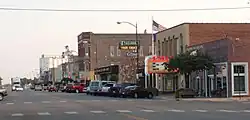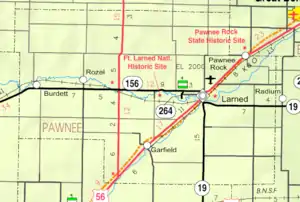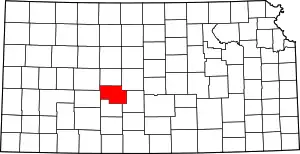Larned, Kansas
Larned is a city in and the county seat of Pawnee County, Kansas, United States.[1] As of the 2020 census, the population of the city was 3,769.[3]
Larned, Kansas | |
|---|---|
City and County seat | |
 Business District (2009) | |
 Location within Pawnee County and Kansas | |
 KDOT map of Pawnee County (legend) | |
| Coordinates: 38°11′00″N 99°06′05″W[1] | |
| Country | United States |
| State | Kansas |
| County | Pawnee |
| Founded | 1870s |
| Platted | 1873 |
| Incorporated | 1886 |
| Named for | Fort Larned |
| Area | |
| • Total | 2.41 sq mi (6.24 km2) |
| • Land | 2.41 sq mi (6.24 km2) |
| • Water | 0.00 sq mi (0.00 km2) |
| Elevation | 2,034 ft (620 m) |
| Population | |
| • Total | 3,769 |
| • Density | 1,600/sq mi (600/km2) |
| Time zone | UTC-6 (CST) |
| • Summer (DST) | UTC-5 (CDT) |
| ZIP code | 67550 |
| Area code | 620 |
| FIPS code | 20-38700 |
| GNIS ID | 485608[1] |
| Website | cityoflarned.org |
History
Larned was laid out in 1873.[4] The first post office was established at Larned in 1872.[5]
The city drew its name from nearby Fort Larned, which operated from 1859 to 1878 and was named for Colonel Benjamin F. Larned, U.S. Army Paymaster from July 1854 to his death September 6, 1862.
Geography
According to the United States Census Bureau, the city has a total area of 2.39 square miles (6.19 km2), all land.[6]
Climate
The climate in this area is characterized by hot, humid summers and generally mild to cool winters. According to the Köppen Climate Classification system, Larned has a humid subtropical climate, abbreviated "Cfa" on climate maps.[7]
Demographics
| Census | Pop. | Note | %± |
|---|---|---|---|
| 1880 | 1,066 | — | |
| 1890 | 1,861 | 74.6% | |
| 1900 | 1,583 | −14.9% | |
| 1910 | 2,911 | 83.9% | |
| 1920 | 3,139 | 7.8% | |
| 1930 | 3,532 | 12.5% | |
| 1940 | 3,533 | 0.0% | |
| 1950 | 4,447 | 25.9% | |
| 1960 | 5,001 | 12.5% | |
| 1970 | 4,567 | −8.7% | |
| 1980 | 4,811 | 5.3% | |
| 1990 | 4,490 | −6.7% | |
| 2000 | 4,236 | −5.7% | |
| 2010 | 4,054 | −4.3% | |
| 2020 | 3,769 | −7.0% | |
| U.S. Decennial Census | |||
2010 census
As of the census[8] of 2010, there were 4,054 people, 1,824 households, and 1,027 families residing in the city. The population density was 1,696.2 inhabitants per square mile (654.9/km2). There were 2,130 housing units at an average density of 891.2 per square mile (344.1/km2). The racial makeup of the city was 92.2% White, 2.7% African American, 0.4% Native American, 0.6% Asian, 0.1% Pacific Islander, 1.4% from other races, and 2.6% from two or more races. Hispanic or Latino of any race were 7.0% of the population.
There were 1,824 households, of which 27.0% had children under the age of 18 living with them, 42.1% were married couples living together, 10.5% had a female householder with no husband present, 3.7% had a male householder with no wife present, and 43.7% were non-families. 39.5% of all households were made up of individuals, and 18.6% had someone living alone who was 65 years of age or older. The average household size was 2.18 and the average family size was 2.89.
The median age in the city was 42.7 years. 23.9% of residents were under the age of 18; 6.8% were between the ages of 18 and 24; 21.9% were from 25 to 44; 27.9% were from 45 to 64; and 19.7% were 65 years of age or older. The gender makeup of the city was 48.0% male and 52.0% female.
2000 census
As of the census of 2000, there were 4,236 people, 1,826 households, and 1,113 families residing in the city. The population density was 1,823.4 inhabitants per square mile (704.0/km2). There were 2,079 housing units at an average density of 894.9 per square mile (345.5/km2). The racial makeup of the city was 90.91% White, 3.75% African American, 0.97% Native American, 0.76% Asian, 1.77% from other races, and 1.84% from two or more races. Hispanic or Latino of any race were 5.38% of the population.
There were 1,826 households, out of which 27.3% had children under the age of 18 living with them, 48.6% were married couples living together, 9.0% had a female householder with no husband present, and 39.0% were non-families. 36.5% of all households were made up of individuals, and 17.8% had someone living alone who was 65 years of age or older. The average household size was 2.20 and the average family size was 2.87.
In the city, the population was spread out, with 23.5% under the age of 18, 6.4% from 18 to 24, 23.3% from 25 to 44, 24.6% from 45 to 64, and 22.1% who were 65 years of age or older. The median age was 43 years. For every 100 females, there were 90.3 males. For every 100 females age 18 and over, there were 87.3 males.
The median income for a household in the city was $33,895, and the median income for a family was $46,776. Males had a median income of $27,138 versus $20,927 for females. The per capita income for the city was $19,936. About 5.9% of families and 7.4% of the population were below the poverty line, including 8.1% of those under age 18 and 10.8% of those age 65 or over.
Education
The community is served by Fort Larned USD 495 public school district.
Media
The local newspaper is Larned Tiller & Toiler.[9]
Economy
- USD 495, local school district
- Larned State Hospital, west of Larned
- Larned Correctional Mental Health Facility, west of Larned
Area attractions
- Santa Fe Trail Center, 1349 K-156 Hwy, museum devoted to the history of the Santa Fe Trail.
- Fort Larned National Historic Site, located approximately 5.5 miles (8.9 km) west of the city of Larned.
Notable people
- Belle Jennings Benchley, "the Zoo lady", former director of the San Diego Zoo
- Gene Keady, current Big Ten sportscaster, former head coach for the Purdue Boilermakers men's basketball team
- Hal Patterson, former professional football player and member of the Canadian Football Hall of Fame
- Glee S. Smith, Jr., former Kansas state legislator and lawyer
- Ralph Terry, retired New York Yankees pitcher, 2× All-Star (1961, 1962), 2× World Series champion (1961, 1962), World Series MVP (1962), AL wins leader (1962), former professional golfer in retirement
- Mitch Webster, retired Major League Baseball outfielder
- John Zook, former football player, all-state, all Big 8 (University of Kansas), and all-pro NFL player
See also
References
- U.S. Geological Survey Geographic Names Information System: Larned, Kansas
- "2019 U.S. Gazetteer Files". United States Census Bureau. Retrieved July 24, 2020.
- "Profile of Larned, Kansas in 2020". United States Census Bureau. Archived from the original on December 3, 2021. Retrieved December 2, 2021.
- Kansas State Historical Society (1916). Biennial Report of the Board of Directors of the Kansas State Historical Society. Kansas State Printing Plant. pp. 260.
- "Kansas Post Offices, 1828–1961". Kansas Historical Society. Archived from the original on October 9, 2013. Retrieved June 22, 2014.
- "US Gazetteer files 2010". United States Census Bureau. Archived from the original on July 2, 2012. Retrieved July 6, 2012.
- Climate Summary for Larned, Kansas
- "U.S. Census website". United States Census Bureau. Retrieved July 6, 2012.
- Weintraub, Boris (April 19, 1984). "Unusual names bestowed on a few U.S. newspapers". The Bulletin. p. 16. Retrieved May 22, 2015.
Further reading
External links
- City
- Schools
- USD 495, local school district
- Historical
- Fort Larned National Historic Site
- Santa Fe Trail Center
- Historic Passenger Rail service in Pawnee County
- Postcards from Larned
- Historic Images of Larned, Special Photo Collections at Wichita State University Library.
- Maps
- Larned city map, KDOT
